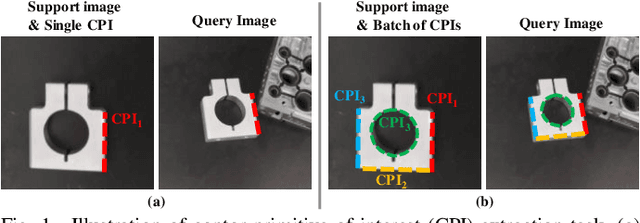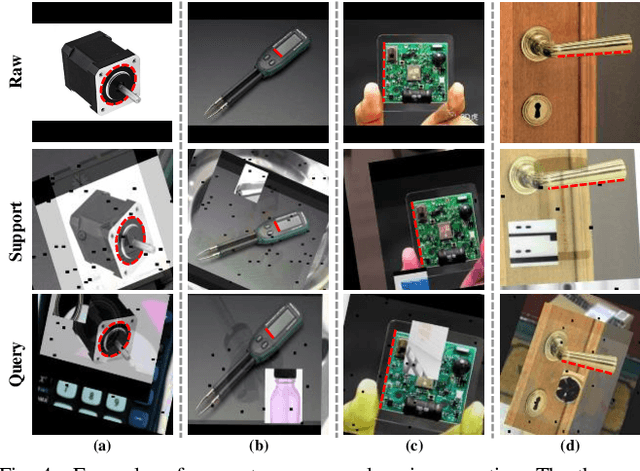De Xu
Contour Primitive of Interest Extraction Network Based on One-shot Learning for Object-Agnostic Vision Measurement
Oct 07, 2020



Abstract:Image contour based vision measurement is widely applied in robot manipulation and industrial automation. It is appealing to realize object-agnostic vision system, which can be conveniently reused for various types of objects. We propose the contour primitive of interest extraction network (CPieNet) based on the one-shot learning framework. First, CPieNet is featured by that its contour primitive of interest (CPI) output, a designated regular contour part lying on a specified object, provides the essential geometric information for vision measurement. Second, CPieNet has the one-shot learning ability, utilizing a support sample to assist the perception of the novel object. To realize lower-cost training, we generate support-query sample pairs from unpaired online public images, which cover a wide range of object categories. To obtain single-pixel wide contour for precise measurement, the Gabor-filters based non-maximum suppression is designed to thin the raw contour. For the novel CPI extraction task, we built the Object Contour Primitives dataset using online public images, and the Robotic Object Contour Measurement dataset using a camera mounted on a robot. The effectiveness of the proposed methods is validated by a series of experiments.
Directional Deep Embedding and Appearance Learning for Fast Video Object Segmentation
Feb 17, 2020



Abstract:Most recent semi-supervised video object segmentation (VOS) methods rely on fine-tuning deep convolutional neural networks online using the given mask of the first frame or predicted masks of subsequent frames. However, the online fine-tuning process is usually time-consuming, limiting the practical use of such methods. We propose a directional deep embedding and appearance learning (DDEAL) method, which is free of the online fine-tuning process, for fast VOS. First, a global directional matching module, which can be efficiently implemented by parallel convolutional operations, is proposed to learn a semantic pixel-wise embedding as an internal guidance. Second, an effective directional appearance model based statistics is proposed to represent the target and background on a spherical embedding space for VOS. Equipped with the global directional matching module and the directional appearance model learning module, DDEAL learns static cues from the labeled first frame and dynamically updates cues of the subsequent frames for object segmentation. Our method exhibits state-of-the-art VOS performance without using online fine-tuning. Specifically, it achieves a J & F mean score of 74.8% on DAVIS 2017 dataset and an overall score G of 71.3% on the large-scale YouTube-VOS dataset, while retaining a speed of 25 fps with a single NVIDIA TITAN Xp GPU. Furthermore, our faster version runs 31 fps with only a little accuracy loss. Our code and trained networks are available at https://github.com/YingjieYin/Directional-Deep-Embedding-and-Appearance-Learning-for-Fast-Video-Object-Segmentation.
Multiple receptive fields and small-object-focusing weakly-supervised segmentation network for fast object detection
May 22, 2019



Abstract:Object detection plays an important role in various visual applications. However, the precision and speed of detector are usually contradictory. One main reason for fast detectors' precision reduction is that small objects are hard to be detected. To address this problem, we propose a multiple receptive field and small-object-focusing weakly-supervised segmentation network (MRFSWSnet) to achieve fast object detection. In MRFSWSnet, multiple receptive fields block (MRF) is used to pay attention to the object and its adjacent background's different spatial location with different weights to enhance the feature's discriminability. In addition, in order to improve the accuracy of small object detection, a small-object-focusing weakly-supervised segmentation module which only focuses on small object instead of all objects is integrated into the detection network for auxiliary training to improve the precision of small object detection. Extensive experiments show the effectiveness of our method on both PASCAL VOC and MS COCO detection datasets. In particular, with a lower resolution version of 300x300, MRFSWSnet achieves 80.9% mAP on VOC2007 test with an inference speed of 15 milliseconds per frame, which is the state-of-the-art detector among real-time detectors.
Adversarial Feature Sampling Learning for Efficient Visual Tracking
Sep 15, 2018



Abstract:The tracking-by-detection framework usually consist of two stages: drawing samples around the target object in the first stage and classifying each sample as the target object or background in the second stage. Current popular trackers based on tracking-by-detection framework typically draw samples in the raw image as the inputs of deep convolution networks in the first stage, which usually results in high computational burden and low running speed. In this paper, we propose a new visual tracking method using sampling deep convolutional features to address this problem. Only one cropped image around the target object is input into the designed deep convolution network and the samples is sampled on the feature maps of the network by spatial bilinear resampling. In addition, a generative adversarial network is integrated into our network framework to augment positive samples and improve the tracking performance. Extensive experiments on benchmark datasets demonstrate that the proposed method achieves a comparable performance to state-of-the-art trackers and accelerates tracking-by-detection trackers based on raw-image samples effectively.
 Add to Chrome
Add to Chrome Add to Firefox
Add to Firefox Add to Edge
Add to Edge